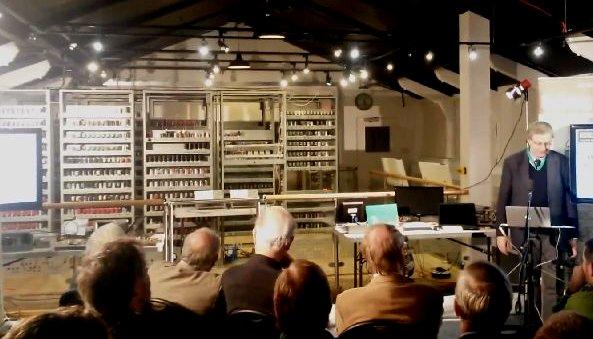Museum switches on historic computer
- Published

An audience was invited to the The National Museum of Computing in Bletchley to witness the event
A project to recreate one of Britain's pioneering computers has reached a key milestone.
The first recreated parts of the re-built Edsac machine at The National Museum of Computing.
The Electronic Delay Storage Automatic Calculator first ran in 1949 and was created to serve scientists at Cambridge University.
Few parts and plans were left of the original which has made the job of recreating the machine a difficult one.
"We don't have blueprints to follow, so to create an authentic Edsac we have to adopt a 1940s mindset to re-engineer and redesign the machine," said Andrew Herbert, leader of the recreation effort.
Students who worked with Edsac's creators have been helping to guide the project, said Mr Herbert.
"We face the same challenges as those remarkable pioneers who succeeded in building a machine that transformed computing."
Mercury tubes
Designed by Sir Maurice Wilkes, Edsac was the first computer specifically designed to be a computational workhorse. As well as aiding scientists, the machine was copied by cake maker Lyons to create the Leo - which was one of the first widely-used business computers.
The original machine used 3,000 valves arranged in a series of racks to crunch numbers, and fills a floor space 20 square metres large.
Built at Cambridge, Edsac was intended to aid scientific research
The machine is being re-built in public at TNMOC and today saw the official opening of the Edsac exhibit and the switch on of the machine's "clock" that will keep all of Edsac's parts working in harmony. Other computational units of the machine will be added and switched on as work progresses.
One element that will not be duplicated in the modern replica is the system Edsac used as its memory store.
The original used long tubes of mercury to hold data but modern-day health and safety rules do not permit these to be used in the museum. Instead, the recreators are using a memory system based on nickel that was used in many machines that came after Edsac.
The work on the recreated Edsac is due to be finished in late 2015. Once finished, TNMOC said children visiting the museum will be able to write programs to run on the venerable machine.
The project began in 2011 and initially its 20-strong team of volunteers only had photographs of the original to work from.
However, in June this year plans of the original were discovered that are now being used to check and guide the work of the Edsac rebuild team.
- Published25 June 2014
- Published11 September 2013
- Published27 June 2013
- Published9 January 2013